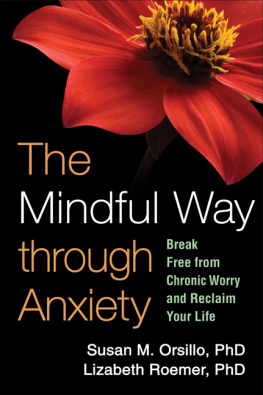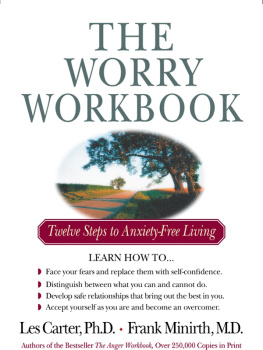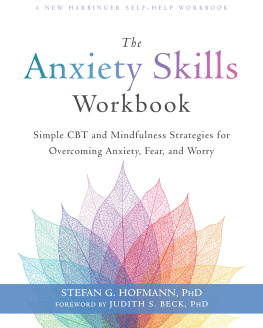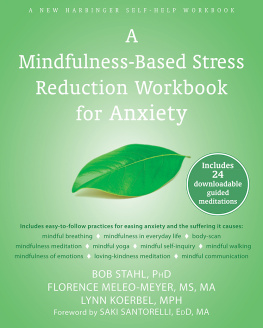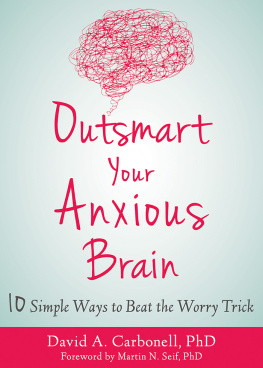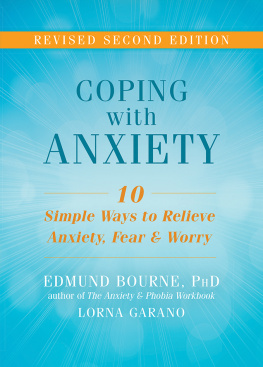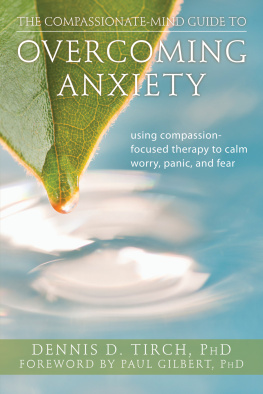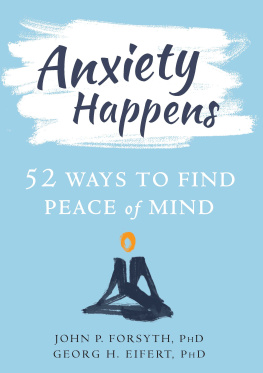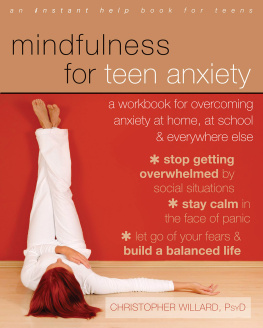A Division of Guilford Publications, Inc.
The information in this volume is not intended as a substitute for consultation with healthcare professionals. Each individuals health concerns should be evaluated by a qualified professional.
No part of this book may be reproduced, translated, stored in a retrieval system, or transmitted, in any form or by any means, electronic, mechanical, photocopying, microfilming, recording, or otherwise, without written permission from the publisher.
The mindful way through anxiety : break free from chronic worry and reclaim your life / by Susan M. Orsillo and Lizabeth Roemer. 1st ed.
p. cm.
Includes bibliographical references and index.
ISBN 978-1-60623-464-8 (pbk. : alk. paper) ISBN 978-1-60623-982-7 (hardcover : alk. paper)
1. AnxietyPopular works. I. Roemer, Lizabeth, 1967 II. Title.
The Mindful Way |
through Anxiety | BREAK FREE FROM CHRONIC WORRY AND RECLAIM YOUR LIFE |
Susan M. Orsillo, PhD
Lizabeth Roemer, PhD
Foreword by Zindel V. Segal

THE GUILFORD PRESS
New York London
Praise for
the mindful way through anxiety
Potentially of great benefit to anyone suffering from anxiety in this era of relentless drivenness, social isolation, stress, and perpetual digital distraction. The authors wise counsel based on their own clinical experience and research, coupled with vivid stories of their own and other peoples lives, provide compelling evidence for why mindfulness is so important in reclaiming your life, and effective guidance in how to go about it in meaningful and very practical ways.
Jon Kabat-Zinn, PhD, coauthor of The Mindful Way through Depression
If youre looking for a fresh way of relating toand healinganxiety, youll find this book an invaluable guide. The authors bring alive the path of mindfulness in a clear and accessible way.
Tara Brach, PhD, author of Radical Acceptance
This book is user friendly, practical, and quite comprehensive. Readers will benefit greatly from the insights and exercises provided in these pages.
Sharon Salzberg, author of Lovingkindness
By far the most sophisticated and engaging guide I have seen on mindfulness and anxiety. This book is a gem. Two of the fields most knowledgeable and creative experts skillfully take you on a journey into the hidden corners of your anxious mind. With a seamless blend of interesting stories, state-of-theart research, and exercises, this book leads you step by step toward a fuller, more meaningful life. It is an excellent resource for anyone who seeks a path to freedom from anxiety and stress.
Christopher K. Germer, PhD, author of The Mindful Path to Self-Compassion
Anxiety is an emotion that begs us to mishandle it through worry and rumination. In a careful, step-by-step fashion, Drs. Orsillo and Roemer show you how to use mindfulness to break free from the grip of anxiety and move forward now toward the kind of life you want to live.
Steven C. Hayes, PhD, author of Get Out of Your Mind and Into Your Life
Whether you suffer from milder worries or a clinical disorder, this book shows you a clear, scientifically validated path toward feeling better. Lots of books propose to teach how to beat anxiety. Some are good, others less so. The Mindful Way through Anxiety is destined to be one of the best. Drs. Orsillo and Roemer are renowned experts in the science of beating anxiety, and their book is readable, informative, and practical.
David F. Tolin, PhD, coauthor of Buried in Treasures: Help for Compulsive Acquiring, Saving, and Hoarding
In the Alice in Wonderland world of emotions, anxiety is the Red Queenalways a future threat and sometimes a present danger. This superb book shows how mindfulness can help ease the ravages of anxiety. Nobody knows more about this topic than Drs. Orsillo and Roemer, and their approach will be a godsend for many.
David H. Barlow, PhD, ABPP, Professor of Psychology and Psychiatry, Boston University, and Founder and Director Emeritus, Center for Anxiety and Related Disorders
foreword
A t the turn of the 20th century, no less a psychological sage than William James recognized that the present moment offers us a wonderful vantage point from which to engage with distressing experiences. But what he was less certain of was how this could be taught to others: the faculty of voluntarily bringing back a wandering attention, over and over again, is the very root of judgment, character, and will... but it is easier to define this ideal than to give practical instructions for bringing it about. Things have certainly changed since then. Today, the clinical uses of meditative practices are oriented toward cultivating a particular form of awareness, known as mindfulness, which originated in the wisdom traditions of Asia. These practices, which have been taught for millennia, have been faithfully adapted for use in modern medical and mental health settings. As the authors of this wise and practical book point out, they also fit remarkably well with the needs of anxious clients who are intent on seeing beyond fitful cycles of worry and engaging with those parts of their lives inadvertently sequestered in the hope of averting further catastrophe.
Combining an accessible writing style with a surefooted clinical sense of those moments when anxiety sings its siren song of protection, the authors describe their approach with a heartfelt understanding of how difficult beginning this work can be. Going against the grain is never easy, much less for clients who are nudged to consider that many of their surefire routines aimed at reducing fear turn out to work against them. Clinical vignettes and case examples vividly illustrate how a narrow focus on the self and an unexamined preference for behaving in ways that ensure an anxiety-free life have high costs, even if they deliver relief in the short term.
The Mindful Way through Anxiety succeeds at conveying these essential insights in two distinct ways. Readers will find a gentle step-by-step structure that first educates them about anxiety in its different guises and shows the relevance of mindfulness backed by explicit guidance for developing these skills. Once established, this sturdy mental platform supports your engagement in practices that may appear at first counterintuitive or threatening, such as befriending emotions, letting go of control agendas, or sharpening the detail of bodily sensations, but turn out to be at the core of this approachs effectiveness. In addition, Drs. Orsillo and Roemers work follows in the best behavioral and cognitive tradition of teaching people how to change their relationship to anxiety rather than eliminate it. Chapter by chapter, the reader comes to appreciate how each of the specific interventions have embedded within them the same metamessages of awareness, investigation, and compassion.
Many readers will use this book effectively on their own, but because the format of their treatment can be so easily incorporated into the framework of individual therapy, readers may choose to work with a clinician to develop mindfulness skills in the context of regulating their emotions. As demonstrated in outcomes from numerous clinical trials, drawing on these skills throughout the day makes it easier to allow distressing moods, thoughts, and sensations to come and go without the need to battle them. In time, those willing to commit to the practice come to see that it is possible to take a wholly different approach to the endless cycles of mental strategizing that are part and parcel of anxiety disorders. What often comes as a surprise is that the route taken for this new learning leads them to discover a range of inner resources for growth and healing that they may not even have believed they possessed. What is clear is that on some occasions this new relationship with anxious thoughts and feelings can cause those feelings to abate, whereas at other times the best one can do is achieve a sort of dtente with his or her problematic emotions so that even in their presence there is more room for living and valued action. Drs. Orsillo and Roemer have done both therapists and their patients a tremendous service in offering

